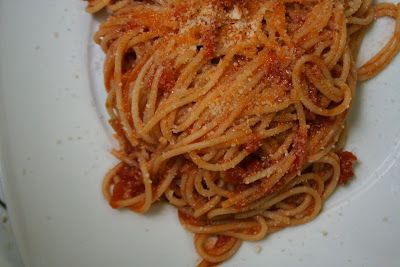
An
article came out recently on CNN Eatocracy about, basically, why "foodie" is a dirty word among chefs. I'm gonna lay it out here: it made me mad.
I should confess that I have a vested interest here. For me growing up, "foodie" was not a dirty word at all - it was praise my dad gave me whenever I was a
good little eater. It meant you loved food, were willing to try new dishes and enjoyed discussing food with people. That's it.
Sometime between my upbringing in a food-loving and minimally pretentious house (my family's from Asheboro, NC, for goodness' sake), "foodie" acquired some negative connotations.
My friend Marti describes foodies as "gross," "navel-gazing" and the foodie movement as "[l]ike some kind of commercialization or trendifying of the love I felt for food." Seattle Weekly writer Jason Sheehan (quoted on
Eatocracy) takes it a step further, calling foodies "coup-counting, lock-jawed, cake-eating, nose-in-the-air dimwits."
OK, so let's be honest here. When people who are passionate about food are that quick to declare themselves absolutely not foodies, what they're really trying to do is distance themselves from people who are elitist and more interested in the impression they make on others than the actual food in front of them.
Let me ask you this. Why is it that adventure travelers can swap Everest-climbing stories or Bruce Springsteen fans can trade tales of the time they were at this concert and they swear the Boss actually looked at them, but the minute a foodie mentions to another foodie how good that mole they had down in Puebla was, or how sweet and down-to-earth Elena Arzak really is, or how perfect North Carolina Sandhills peaches are in the summer, they are immediately branded disingenuous and elitist?
Since when is it by definition elitist and affected to share my passion with other people who have the same passion?
Let's get even more honest, though, since I was really giving anti-foodie food lovers the benefit of the doubt there. In some cases, it seems an awful lot like distancing themselves from the elitist boors they call foodies is a way to show how much more elite they are than the elite.
Because here's what frustrates me about exhortations from anti-foodies to "shut up and eat:" you know they're not about to. Of course they are still going to talk about food; they're interested in it and for Pete's sake, talking is what people who are interested in something
do when they're with others who share their interest. And so what may have been intended as a battle cry for the purity of flavor, untinged by the flapping of gums about it, ends up sounding like: "I can talk about food; you can't."
Another common complaint against foodies, so the argument goes, is that it's a label used to differentiate oneself in a separate (higher) social class. Of course there are plenty of people who will seize whatever they can in a bid of "look how rich I am," but I'm calling BS on foodie-ism being intrinsically so.
First of all, people of the very lowest income brackets can get ingredients and take an interest in how to put them together in tasty ways. They can appreciate things they think taste good, and they can talk with their friends about it. For goodness' sake, have we learned nothing from Anthony Bourdain's countless diatribes about how the best cuisines of every nation sprung from necessity - poor people figuring out how to cook the cheapest things well? If anything's elitist, it's the assumption that people without a high income can't be foodies.
Second of all, and I know this is a crazy thought, but terms exist to differentiate things from other things. What do I mean here? Not all people are fascinated by food. This doesn't make them less civilized or lower-class any more than not being a kayaker or a pop art fan or a ukelele player.
People have different interests, and not everyone's is food. Anyone who looks down on people with different interests then theirs is first and foremost antisocial, not a foodie.
Oh, but cooks hate foodies, you say. Foodies are always being jerks in restaurants and making the chefs come out so they can look important in front of their friends. Foodies are always sending food back because they can. Foodies are only interested in chasing trends, not the purity of flavor.
Here's the thing: you haven't just described foodies. You've just described pretentious jerks, obnoxious bullies, and silly trend-chasers. And excuse me, but I guarantee you that there are pretentious jerks, obnoxious bullies and silly trend-chasers who are rock climbers, art fans, ukelele players and so on. We don't stop using the terms "rock climber," "art fan" and "ukelele player" just because there are jerks who do those things. We let the words keep their original meaning.
"Foodie," I should point out, came about as a term to describe people who loved food because "gourmet" sounded too pretentious. Sound familiar? A question for all the foodier-than-thou anti-foodies out there: what term do you suggest? If we go running from "foodie" next, how do we describe people who have a serious interest in food?
Another question: let's say you have a deep respect for cooks as professionals. You truly appreciate good ingredients prepared creatively or even just well and simply. You tip generously. You don't look down on people who don't share your interest in food. Now, how many cooks are seriously going to hate you just because you call yourself a foodie?
I thought not.
A thought for lovers of food: let's spend less energy punishing the language for the behavior of a few pompous jerks and more energy on being good examples of what a foodie really is.
My name is Kit Cox, and I am a foodie.






























